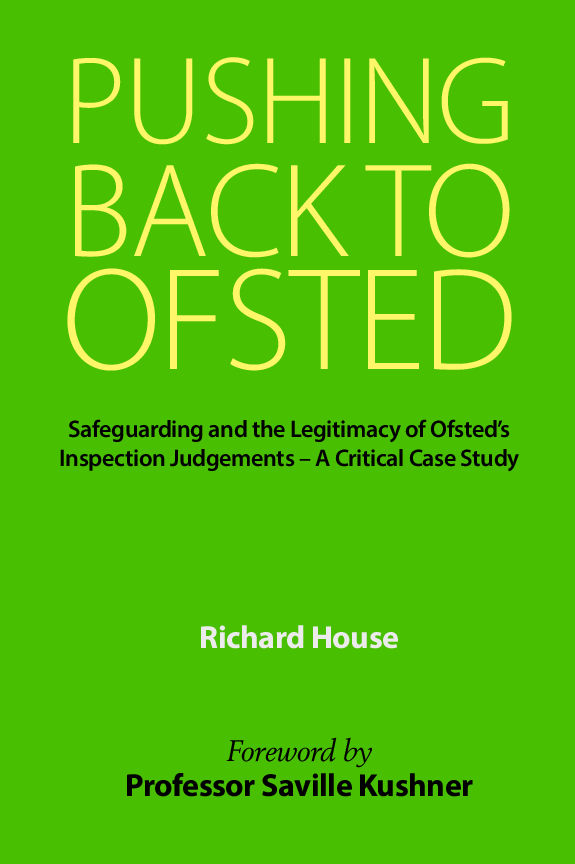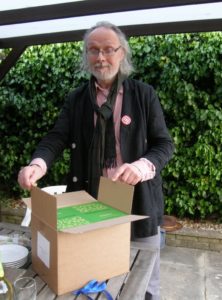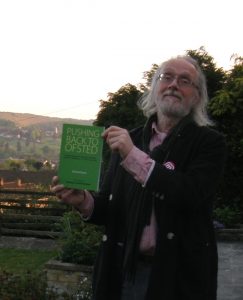Pushing Back to Ofsted

Out now! –
Pushing Back to Ofsted: Safeguarding and the Legitimacy of Ofsted’s Inspection Judgements – A Critical Case Study
by Richard House
InterActions, April 2020
ISBN: 9780952836421
Pb, 128pp, £10.99
Now Available from:
Wynstones Press www.wynstonespress.com (click for direct link)
Also available on Amazon. Buying directly from Wynstones Press, distributors for InterActions, enables more funds to be donated to an action fund for future cases that may arise.
A PDF version of the book, or a book copy, is available from the author for published review purposes (the PDF version does not contain the Index and Afterword of the print edition). Contact: richardahouse@hotmail.com.
Book Reviews
NEW BOOK REVIEW of Pushing Back to Ofsted, by a former long-standing lead Ofsted inspector!!
Link and download courtesy of Self&Society
Click here for a direct link to the online Self & Society edition
Click here to download a PDF copy of Faysal Mikdadi’ book review essay, entitled, Beneath the Sky.
Beneath the Sky
by Faysal Mikdadi
Introduction
From 1992, when Ofsted was first set up, till August 2016 I led Inspections in hundreds of secondary schools. I also took part as an inspection team member in numerous Ofsted inspections of primary and secondary schools, SEND schools and Pupil Referral Units, and in universities and other organisations offering initial teacher training.
School evaluations of the inspection process always returned with glowing comments – except for one school that made an official complaint to Ofsted because its headteacher felt that our judgements were wrong. Ofsted revisited the school and found a face-saving way out of the complaint. The headteacher was still unhappy with the outcome.
One school wrote to Ofsted thanking them for sending me as the then Registered Inspector. In itself this would be a mere courtesy. However, the school concerned had been put into Special Measures. The headteacher felt that the inspection process was ‘fair’ and ‘humane’. She added that she felt that the dialogic process employed by my team and myself was one that culminated in giving the school an agenda for improvement that it could work with. I was reprimanded by my line manager for being ‘too friendly’. On another inspection, a visiting HMI took me aside and suggested that I should try to ‘smile less’ because my demeanour was giving the school an impression that I might be ‘a walk-over’.
These are but two little anecdotes of the many experiences that I and my colleagues had during our inspection work. They are testaments to the veracity of House’s judgement that Ofsted acts as an ‘enforcer’ using a ‘blunderbuss approach’ where it goes ‘beyond the regulations allowing varying interpretations of inspectors who then go on to inspect and measure compliance to these interpretations’.
These, and many other similar experiences, lead one to assume that Ofsted lives in a parallel universe that bears little connection to what goes on in the real world. Consequently, the so-called Education Inspection Framework is largely incapable of deviating from the one-model-fits-all ideology that propels its scrutiny, evidence gathering and judgements. It becomes impossible for blinkered inspectors to be able to see a particular school context of any kind. Ofsted has a clear idea of what constitutes good schooling: all else must be suspect, regardless of context or differing ideologies….
(For continuation, click here for a PDF of the full review)
Book Review by Matthew Barton, reprinted courtesy of New View
Let us imagine, for a moment, a fantasy land in which an inspectorate of dogs is tasked with assessing every dog in the country to check whether it meets the criteria for dog-hood. Those that do not must be put down. Let us then imagine that in
this land, in which cats are unknown, a dog inspector encounters a cat. The ensuing report will no doubt find copious fault with this creature, which clearly does not meet many of the ‘dog’ criteria. Let us imagine such a report for a moment:
This animal completely failed to satisfy the standards required for dog-hood. Not only is its bark a merely unrecognizable whining noise but it will not walk at heel or express doglike satisfaction upon seeing its owner. It responded with no interest whatever when the inspectors threw a stick for it to fetch but instead arched its back and hissed in a completely unwarranted fashion. Despite repeated efforts to teach this animal habits proper to a dog, it failed to respond with any enthusiasm. We therefore have no hesitation in requiring immediate elimination of this creature, which does the species of dog a grave disservice.
In the book under review, Richard House – a former senior university lecturer in Education Studies and Psychology, a chartered psychologist and former Steiner Kindergarten teacher – has documented the outlooks and actions of Ofsted, the Schools’ Inspectorate, with particular reference to the closure this year of Wynstones School – a Steiner school of long standing. He argues compellingly that Ofsted failed, at the very least, to recognize the ‘creature’ it was looking at. In this brief but carefully argued book, he calls into question the prevailing orthodoxy at work in education in this country and calls for a reassessment of its rigid and stultifying effects.
When Ofsted caused the closure of Wynstones in January, my grandson, just one of its 250 pupils, was in the middle of his GCSE year. A gifted, very artistic lad, with dyslexia, he found Wynstones a safe, supportive, friendly and warm environment. His world was thrown upside down and for a while he experienced panic attacks. The small private school he went to subsequently, which very kindly took in some of his class, was in his view not only less interesting and supportive but also more disorganised. His sense of trauma and upheaval in the wake of Ofsted’s inspection is matched by that of many others whose experiences
are documented in the appendix to this book.
Here are just three of these many heart-wrenching accounts:
The school’s closure has been really difficult for our entire family. My children have been shocked and traumatised.
We are all devastated and heartbroken by the closure.
The close-knit community, which we and our children are a part of at Wynstones, has been blown to pieces. Children who have been close friends are scattered. All the extra-curricular enrichment activities, such as morning singing, choir, crafts, PE and school trips, are lost. All their connections with the other classes, the teachers and support staff, all their routines are lost… There is no closure, and no celebration of the time they have spent together. We are in a grieving process…
So what could possibly have justified such a drastic action as closing a school with no notice and leaving so many children and families devoid of support or education? No one is suggesting that all was well at Wynstones. In fact, since an Ofsted report the previous November, Richard House believes that a damaging climate of fear had infiltrated the school, and, as fear does, had been hampering enthusiasm and paralysing creativity. At the same time, he suggests, there were divisions between those who wished to keep the school open at all costs through compliance with the inspectorate, and those who believed this would crush the school’s core values. No doubt there were ingrained inadequacies in many areas, and problems that sorely needed addressing. But is this a reason to shut down a school in the middle of a year, causing havoc and pain for so many families?
Amongst many apparently damning indictments of Wynstones listed in the closure report, which House analyses in minute detail and largely refutes, the overriding reason for closure was the issue of ‘safeguarding’. This did not refer to any actual event that had transpired in which a child had actually suffered harm, but to the possibility that harm might occur. One of the most fascinating sections in the book is House’s close analysis of this whole safeguarding area, his exposition of a culture that tolerates no risk, yet can leave children and their teachers and families less safe in consequence, and in this case drastically pulled the rug of security and stability out from under them.
There are two main aspects of the problem with ‘safeguarding’: firstly, and self-evidently, children learn to be safe by taking calculated risks and need to be allowed to do so, by measuring themselves against challenges, and sometimes learning by mistakes or even accidents. In other words, as House points out, freedom and risk go hand-in-hand. Of course it is the job of parents and teachers to keep children safe, but, as House argues, citing many non-Steiner educationalists, this is not best done in a low-trust, prescriptive and completely risk-averse environment. The line between safety and freedom is one that needs monitoring, he says, by teachers’ professional judgement rather than by “narrowly rule-bound proceduralism”.
Secondly, House explores the current child protection situation in this country and highlights, again, the climate of fear and distrust in which teachers are legally required to flag up the least sign that something may be wrong at home, and always to assume the worst. Teachers therefore live in what House calls a “cognitive dissonance” between their own intuitive, first-hand appraisal of each child’s circumstances and home situation, and the requirement to notify the least “sign” of concern, leading to drastic ensuing interventions by the state apparatus which can often have far more damaging effects on children and families. Teachers are understandably reluctant to deliver children up to the “child protection machine”, but this puts them on the wrong side of the law.
It is beyond the scope of this review to list all of Ofsted’s indictments and House’s thoughtful and painstaking analysis of, and argument with them. But he does show, tellingly, how the very language of the Ofsted report invests narrow and subjective views of what education is and should be with the mantle of objective authority. Time and again the closure report makes sweeping and unsubstantiated judgements without offering evidence for these assertions. Broad, highly generalised statements such as “Staff have put pupils at serious risk due to lack of supervision”, or “The risk assessment policy is not fit for purpose” do not, for example, explain what the serious risk may be, or define what “purpose” such policies are unfit for. One might well retort, as House does, by asking what safeguards Ofsted itself had in place to prevent its own self-confirming bias.
In the end it comes down to a narrow and prescriptive view of what education should be, a template of orthodoxy imposed upon a ‘creature’ to which it bears little relation; one intrinsically opposed to educational models that allow for risk, creativity and freedom, as well as for unconscious elements in learning or for the whole atmosphere of a school, including the basic sense of trust that children and parents have in it despite inevitable failings and inadequacies. The ‘good enough school’ it seems, is no longer good enough. It must comply with punitive strictures and embrace whole orthodoxies of outlook, right down to teaching reading according to simplistic dogmas. Otherwise it will be ‘eliminated’.
Here are two more parent responses:
From our point of view the school was a good one and we had full confidence in the teachers and the safety of the children who loved the school and were happy for their first six years to run into school skipping…
He never felt unsafe at Wynstones. None of the 30 or New View 84
40 families we know have any first-hand knowledge (let alone adverse experience) of safeguarding issues in general, let alone the specific issues that have ostensibly got Ofsted’s alarm bells ringing.
The sense that Ofsted has been specifically targeting Steiner schools in the last couple of years is not unfounded. House quotes from a letter written to the Education Minister in 2019 by the head of Ofsted, Amanda Spielman, in which she directly questions the principles of Steiner education and asks for enforcement action against them if they are found to be “inadequate”. (Once again, we must interrogate the very concept of ‘adequacy’ here.) It does seem clear that Ofsted inspectors may have been given carte blanche, at the very least, to regard Steiner schools negatively and to form a fixed or narrow opinion about them in advance of any inspection. They may well have felt explicitly encouraged by their chief to take draconian action against such a school, and, when actually setting foot in it, to fail to see that what was under their noses was not at all the creature their preconceptions required it to be.
With the current coronavirus crisis, some strange and interesting silver linings may emerge. Ofsted’s inspections have all been suspended, and I could imagine that what is currently happening in schools catering for keyworkers and ‘children at risk’, as well as in home schooling efforts throughout the land, might tap into a freer, more creative mode of unassessed and unregulated education, one that allows teachers and parents to breathe a little more freely again, to feel empowered to take creative risks and find creative solutions unhampered by the prescriptive, restrictive hand of government control. Is this very virus, which attacks our respiratory system, in fact drawing our attention to the breathlessness of tight statutory controls and rigid thinking, and teaching us that we need to learn to breathe again?
Matthew Barton

